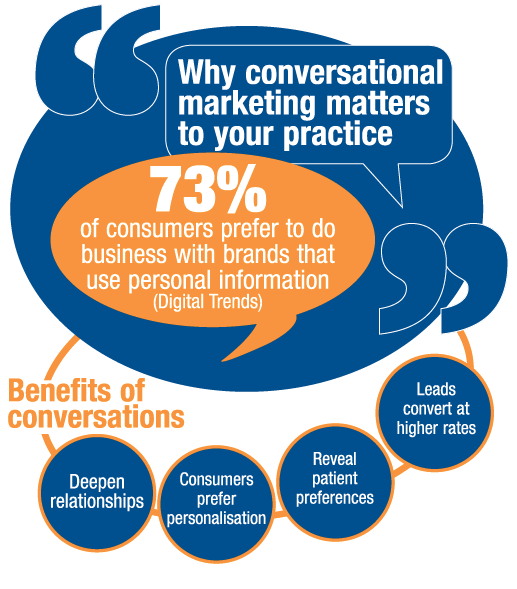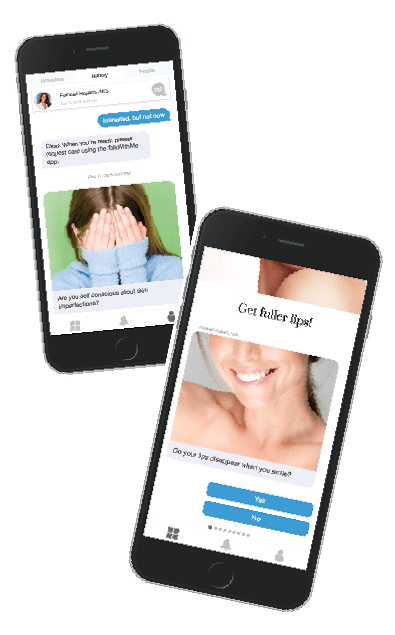As traditional marketing strategies begin to lose their appeal, Bob Fabbio explains how conversational marketing can improve both your bottom line and your relationship with your clients.
As a successful aesthetics and anti-ageing professional, you’ve built your reputation on relationships. And you understand what it takes to maintain them. Two-way communication is an essential way to nurture and grow any healthy relationship. But while conversations are standard practice for your in-person client interactions, when it comes to your marketing communications, does the conversation stop?
Conversations help you understand client needs and provide service and recommendations that solidify trust, confidence, and loyalty. It’s this understanding and intelligence that make good practitioners even better. So it only makes sense to extend those valuable conversations to your marketing communications.
Successful dermatologists, plastic surgeons, aestheticians, and med spas have begun to leverage conversational marketing to more deeply engage clients, improve loyalty, and increase revenue. If your marketing campaigns rely exclusively on one-way channels like email, you’re missing these important opportunities to grow.
How the conversation flows
Most traditional marketing channels flow in one direction. If you only send emails, mail postcards, or buy online or print ads, you’re doing all the talking and learning very little. One-way communication wouldn’t work in a client consultation, and it isn’t effective marketing.

Conversational marketing is perfectly suited for aesthetics practices because it leverages the trusted client-provider relationship. It’s about listening—not just talking — to secure lasting connections.
An app for that
Conversational apps, or ChatBots, (through mobile and desktop apps and SMS texting) effectively bring
the latest two-way communication channel to marketing for aesthetic practices and med spas. They create interactions that feel like personal, uninterrupted, real conversations.
The apps can identify clients’ interests in products and services — even glean their hobbies and personal interests to deepen connections — and engage them on topics of their choice, with appropriate responses throughout the conversation. These automated conversations can progressively become more personalized, and the technology can remember and cue interests or other information from prior interactions.
The client data collected can be used to enhance other in-office interactions as well as segment communications through other digital channels.
Conversations deliver conversions
Leads from conversations tend to convert at higher rates than other digital marketing channels because the conversational channel is the truest form of permission-based marketing. Clients are choosing to engage in bi-directional interaction around topics of interest.
The personalized information collected through conversations also allows you to remain above the consumer marketing noise. When fighting for patient mind-share, it’s easy for messages to get lost in the shuffle. A key to breaking through the clutter is to deliver personalized and relevant communications. In fact, 90 percent
of marketers see individualization as the future of marketing — moving beyond segmentation to true one-to-one personalization in a real-time context1.
Results in practice
Dr. Jeffry and Selena Rocker own and run Skinology, an Orlando-area medical spa. In February 2016, the Rockers began leveraging data collected from a conversational smart phone app to generate more business from clients during office appointments. In less than 100 days after using the app as part of a multi-channel marketing approach, the practice grew revenue by 15 percent.
‘If we see (from the conversational app) that they wanted to know more about Latisse, for example, we can use the time we have with them during a Botox appointment to answer their questions about Latisse,’ Rocker says. ‘We’ve seen this result in more business.’
A multi-channel approach is still necessary
The addition of a conversational channel should be part of a fully-integrated marketing program, not stand alone. No single channel can reach everyone in this online and offline world. Consumers expect choices and want to communicate and have conversations on their terms.
Remember, people have communication preferences, so you’ll reach the most targets, at the most opportune times, when you’re not dependent on a single channel.
For Hurricane, West Virginia-based Paul A. Blair Facial Plastic Surgery and Alex Alexa Medispa, a multi-channel approach is fueling growth by capturing the attention, and wallets, of its clients.
Since early 2016, the practice has been executing integrated campaigns through six digital marketing channels: branded email, text messages, push notifications, targeted Facebook ads, web landing pages, and automated conversational content on a smart phone app.

Because the practice previously used only email, the multi-channel campaigns are reaching far more people. About 40 percent of the total appointment requests from the multi-channel campaigns have come from a conversational mobile app, targeted Facebook ads, and SMS texting.
Conversational marketing supplements and reinforces other digital marketing efforts, including email, web, and
social. The beauty of conversational marketing is that it fits well into a multi-channel approach while delivering benefits other channels cannot.
A final note
Implementing automated conversations into a digital marketing campaign will likely require the help of an expert, but aesthetic practices and med spas making the investment are reaping big rewards. You may have to overcome some initial technology and resource challenges to get started, but so far, I haven’t met a practice that says they regret taking the leap.





